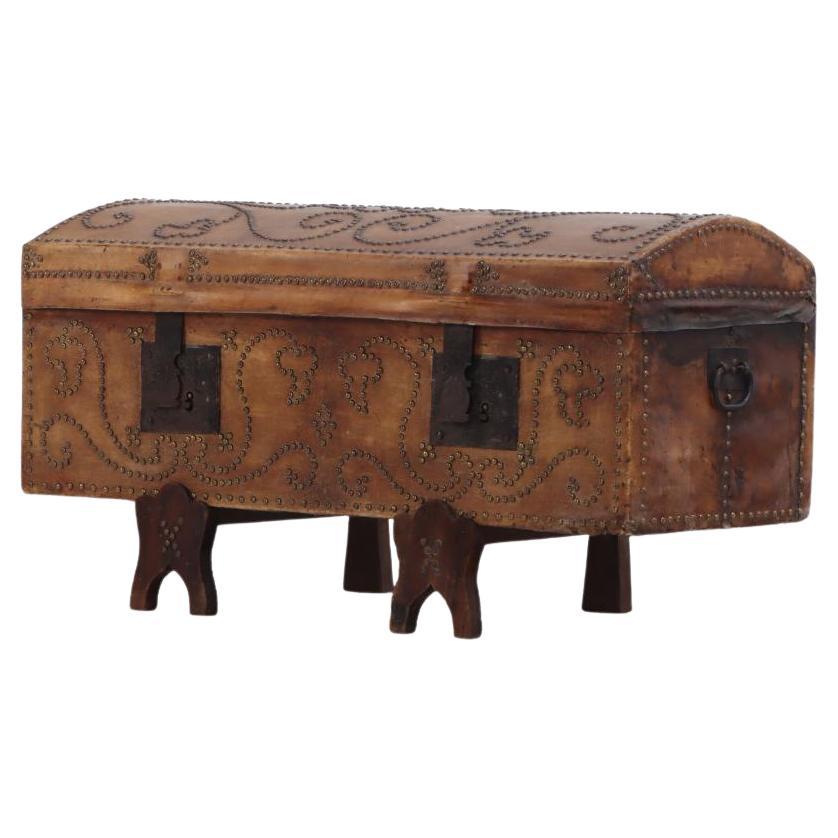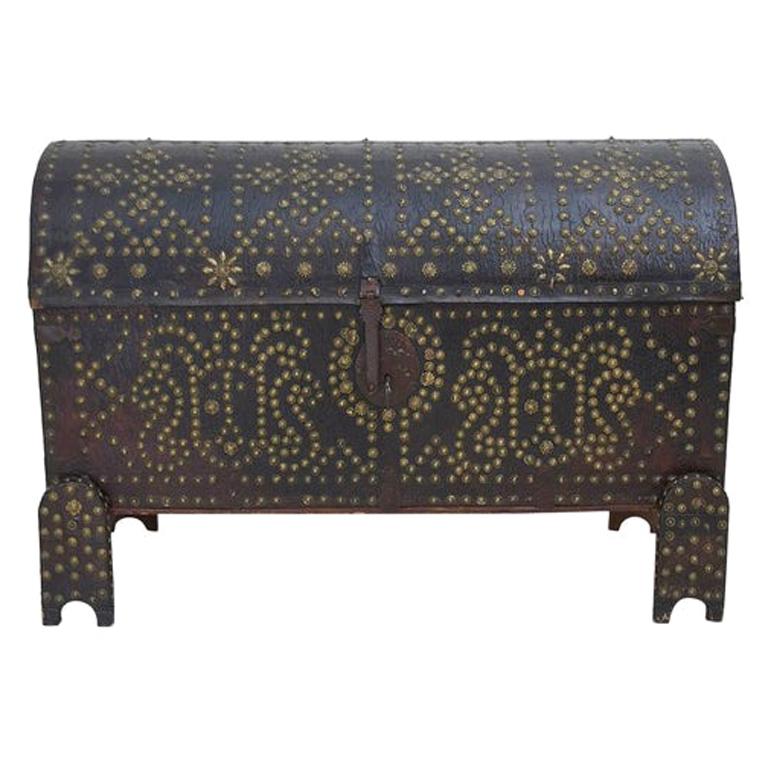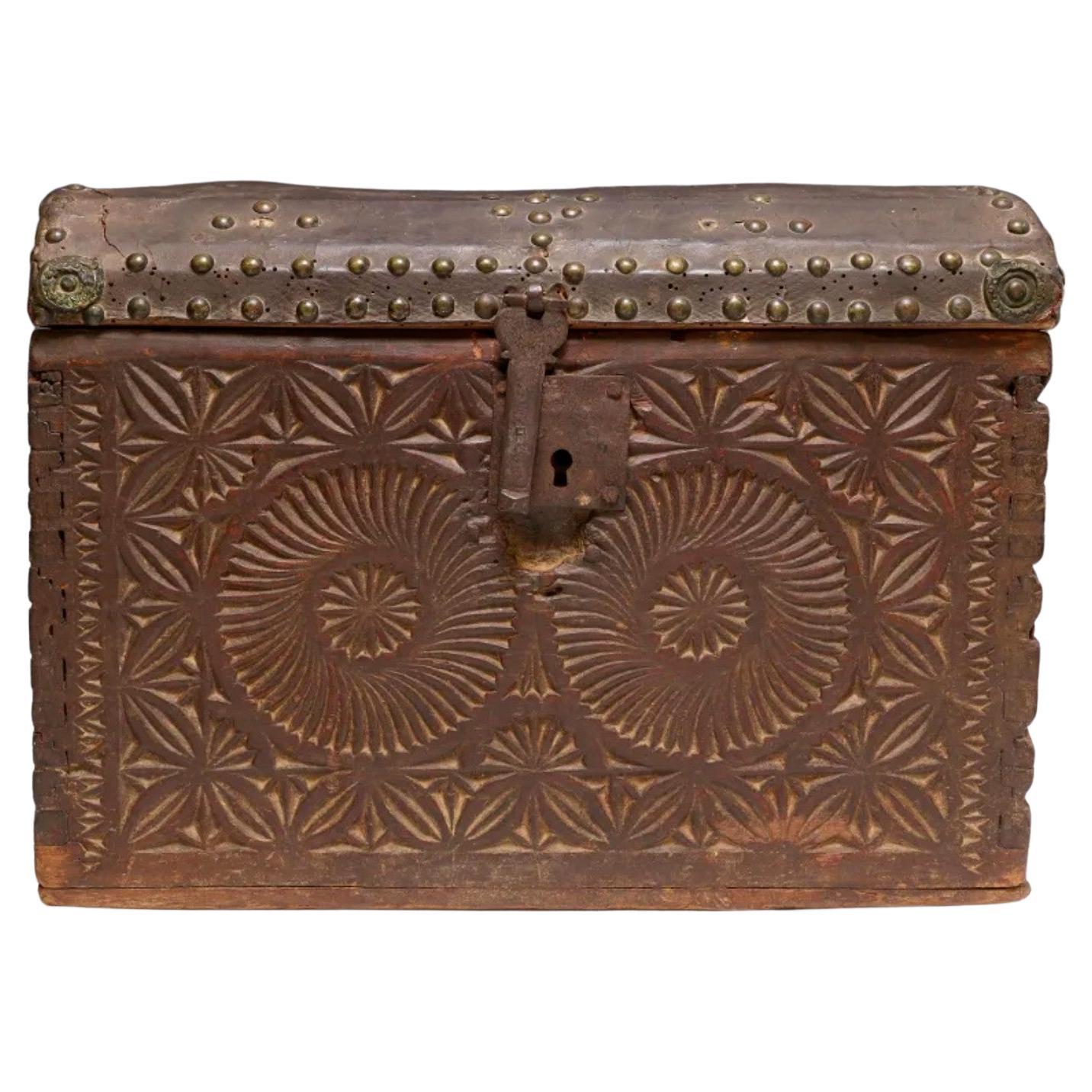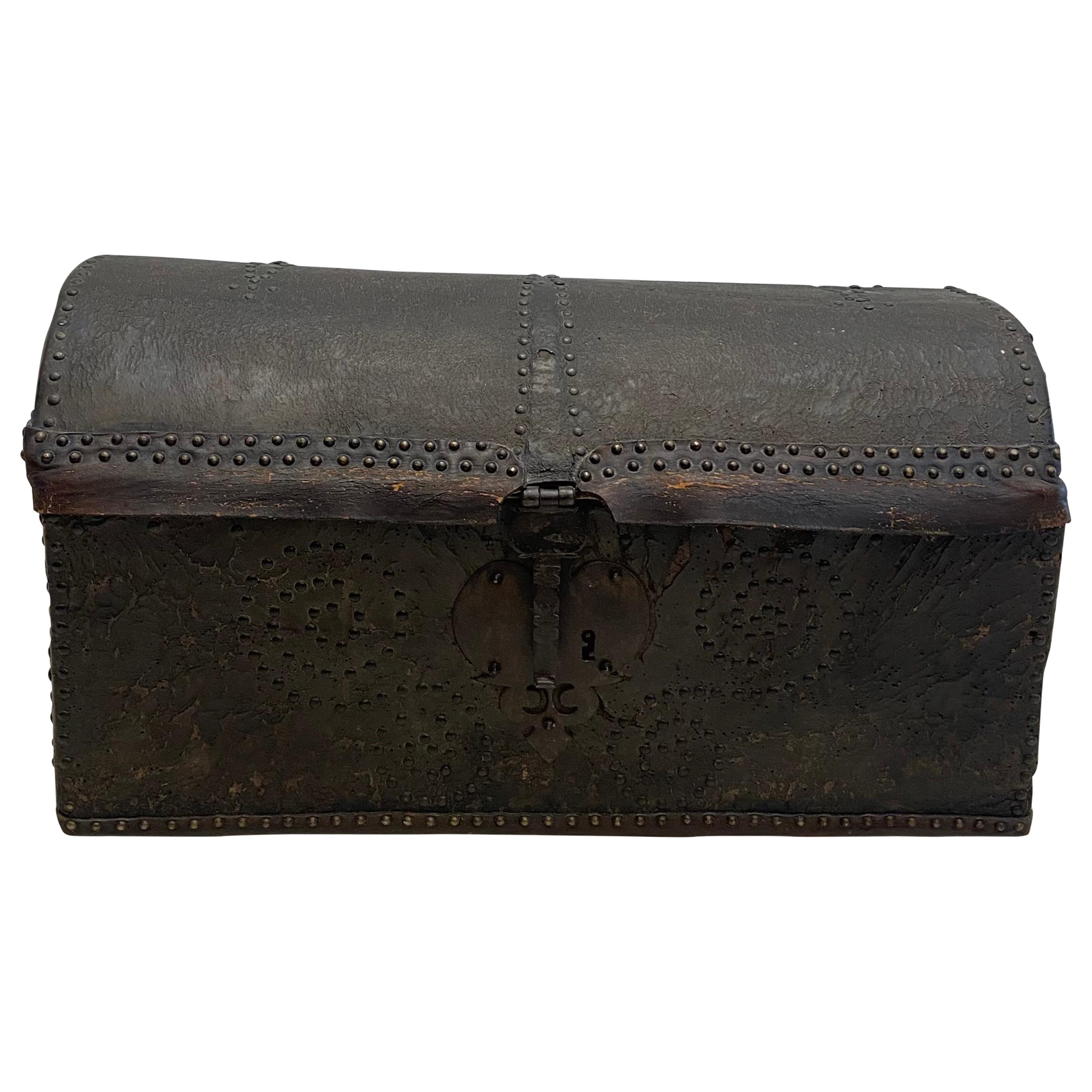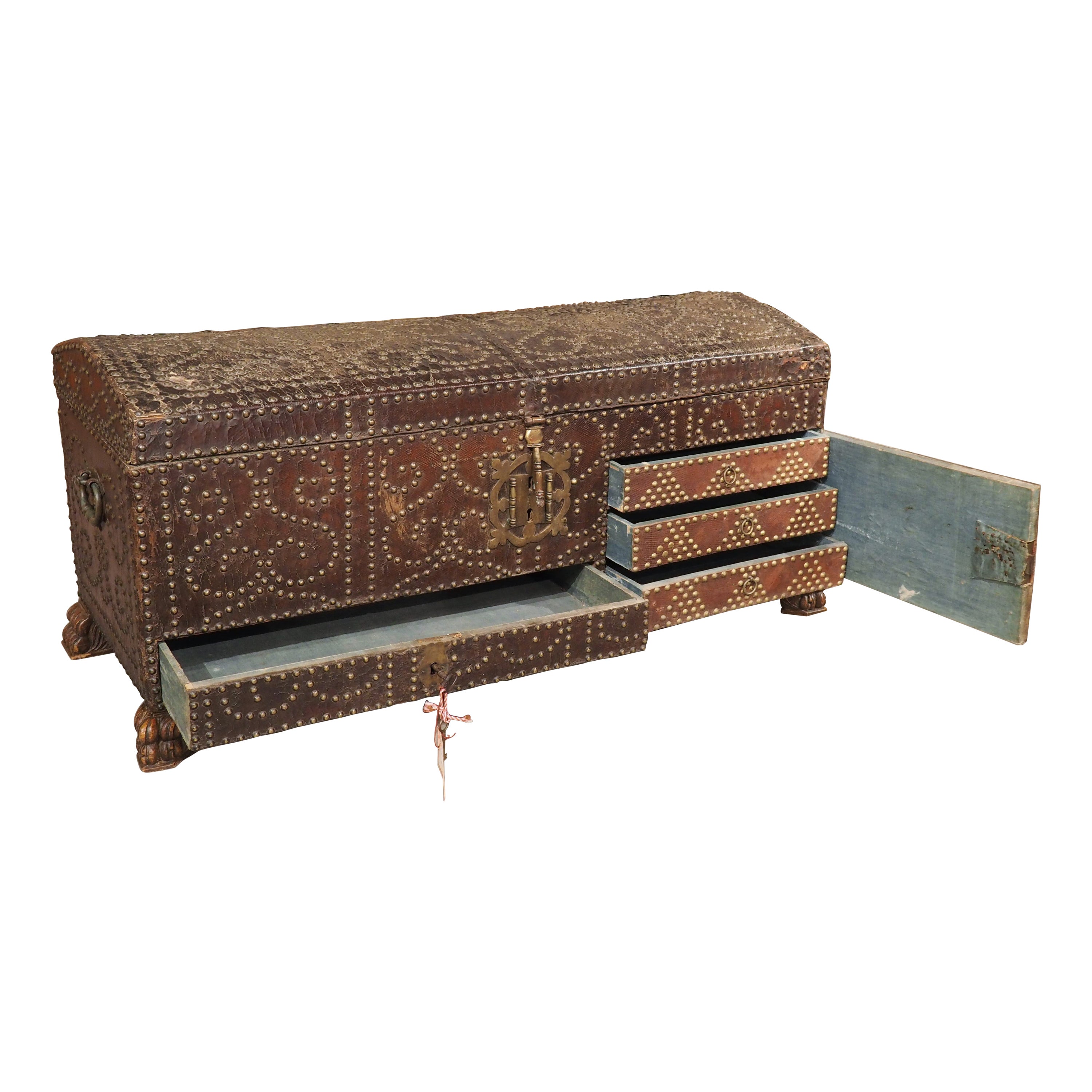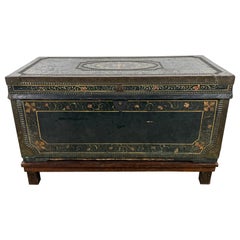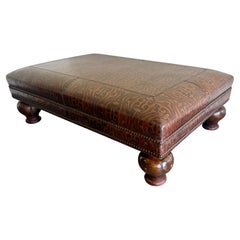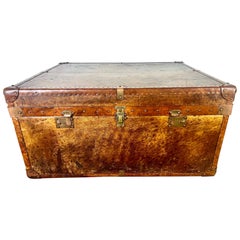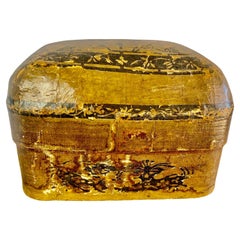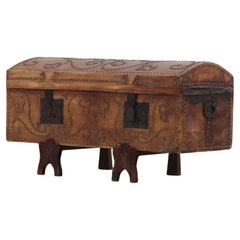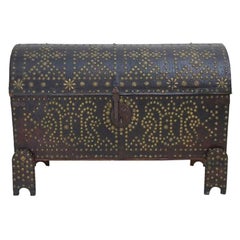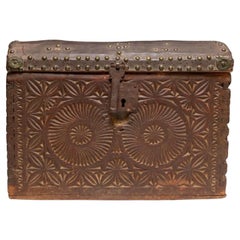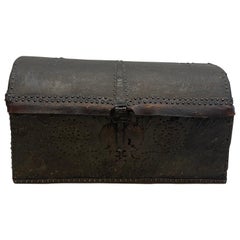Items Similar to 19th Century Spanish Colonial Leather Dome Trunk with Studded Decoration
Want more images or videos?
Request additional images or videos from the seller
1 of 16
19th Century Spanish Colonial Leather Dome Trunk with Studded Decoration
$2,400
£1,805.30
€2,080.92
CA$3,380.67
A$3,709.40
CHF 1,941.33
MX$45,650.10
NOK 24,457.78
SEK 22,908.36
DKK 15,537.97
About the Item
A rare and character-filled Spanish Colonial dome-top trunk, late 19th century, clad in original hair-on cowhide with geometric patterns formed from decorative metal studs. The rich, organic texture of the hide is framed by carved wood trim, creating a striking contrast with the rustic metal hardware and lock plate.
The trunk retains its original iron side handles, dome-shaped top, and a naturally aged patina that speaks to decades of travel and use. Inside, it is lined with a vividly printed textile interior in vibrant orange and purple, depicting folkloric scenes with exotic animals and botanical motifs—an unexpected and whimsical contrast to the rugged exterior.
This piece is both functional and decorative, ideal for use as a statement coffee table, end-of-bed storage, or an evocative display of colonial craftsmanship.
- Dimensions:Height: 14 in (35.56 cm)Width: 38 in (96.52 cm)Depth: 19 in (48.26 cm)
- Style:Spanish Colonial (Of the Period)
- Materials and Techniques:
- Place of Origin:
- Period:
- Date of Manufacture:1870-1880
- Condition:Wear consistent with age and use.
- Seller Location:Los Angeles, CA
- Reference Number:1stDibs: LU842746012412
About the Seller
4.9
Vetted Professional Seller
Every seller passes strict standards for authenticity and reliability
Established in 1998
1stDibs seller since 2008
1,011 sales on 1stDibs
Typical response time: 1 hour
- ShippingRetrieving quote...Shipping from: Los Angeles, CA
- Return Policy
Authenticity Guarantee
In the unlikely event there’s an issue with an item’s authenticity, contact us within 1 year for a full refund. DetailsMoney-Back Guarantee
If your item is not as described, is damaged in transit, or does not arrive, contact us within 7 days for a full refund. Details24-Hour Cancellation
You have a 24-hour grace period in which to reconsider your purchase, with no questions asked.Vetted Professional Sellers
Our world-class sellers must adhere to strict standards for service and quality, maintaining the integrity of our listings.Price-Match Guarantee
If you find that a seller listed the same item for a lower price elsewhere, we’ll match it.Trusted Global Delivery
Our best-in-class carrier network provides specialized shipping options worldwide, including custom delivery.More From This Seller
View All19th century hand-painted American immigrant trunk
Located in Los Angeles, CA
An exceptional 19th century hand-painted American immigrant trunk bearing the name Henry A. Tefft of Racine, Wisconsin, richly decorated in a folk-art floral motif. This rare survivo...
Category
Antique 19th Century American Folk Art Antiquities
Materials
Leather, Wood, Paint
Large Embossed Leather Ottoman with Bun Feet
Located in Los Angeles, CA
A substantial rectangular ottoman upholstered in richly embossed leather, mid-20th century. The warm brown leather features an elegant damask-inspired pattern with subtle tonal varia...
Category
Early 20th Century Spanish Spanish Colonial Ottomans and Poufs
Materials
Leather, Wood
19th C. English Leather Coffee Table/Steamer Trunk
Located in Los Angeles, CA
A 19th Century steamer trunk that can be used as a coffee table, featuring original brass and copper hardware, with beautifully distressed leather in good condition. This piece is d...
Category
Antique 19th Century English British Colonial Coffee and Cocktail Tables
Materials
Copper
$2,240 Sale Price
41% Off
19th C. Chinese Paper Machiere Box
Located in Los Angeles, CA
19th century lidded box made from paper-machiere.
Category
Antique 19th Century Chinese Chinese Export Decorative Boxes
Materials
Paper
$480 Sale Price
60% Off
Antique Spanish Colonial Style Carved Writing Table with Drawer
Located in Los Angeles, CA
A richly detailed Spanish Colonial style writing table, showcasing masterful hand-carved craftsmanship and a timeworn painted patina. The rectangular top features a beveled edge and ...
Category
Antique 19th Century Spanish Spanish Colonial Desks and Writing Tables
Materials
Wood, Paint
Pair of Louis Xv Style Bombe Chests
Located in Los Angeles, CA
This charming pair of Louis XV style bombe chests brings timeless French elegance with a rustic twist. Featuring classic serpentine fronts and sides, these beautifully curved chests ...
Category
Vintage 1930s French Louis XV Commodes and Chests of Drawers
Materials
Pewter
$3,800 / set
You May Also Like
A Spanish studded leather domed trunk, C 1870.
Located in Philadelphia, PA
Wrapped in a light shade of leather, the metal stud decoration stands out on a trunk raised on gothic arched wooden supports. It will look wonderful on a sofa table as a hiding spot ...
Category
Antique Late 19th Century Spanish Decorative Boxes
Materials
Metal
Antique 18th Century Spanish Leather Trunk with Decorative Nailhead Detailing
Located in Madrid, ES
An excellent example of the classic dome top Spanish "arcón" or travel chest / trunk. Constructed of wood, the exterior is completely covered in a dark brown leather and the top and front feature studded brass nails arranged in decorative patterns. The nailheads themselves are decorated with raised star shape. The functioning lock mechanism (key included), hasp and side carry handles are original and made of wrought iron. Included are a pair of matching studded leather "feet" or supports which raise the trunk off of the floor allowing air to circulate, thus protecting the bottom from moisture. A solid and useable trunk...
Category
Antique 18th Century Spanish Spanish Colonial Trunks and Luggage
Materials
Wrought Iron
Antique Spanish Colonial Period Leather Carved Cedar Travel Chest
Located in Forney, TX
A scarce 300-year-old Spanish Colonial period leather clad and carved travel chest with beautifully aged patina. circa 1725
Born in the first half o...
Category
Antique 17th Century Spanish Colonial Blanket Chests
Materials
Iron
18th Century Leather Dome Top Trunk
Located in West Palm Beach, FL
18th century leather dome top trunk in good condition… With brass nail heads and brass bail pulls at the sides… The front lock does not work but...
Category
Antique 18th Century Queen Anne Trunks and Luggage
Materials
Leather, Wood
18th Century Spanish Studded Leather Trunk with Lockable Compartments
Located in Dallas, TX
With two lockable compartments on the front façade, this studded leather trunk is a very unique storage piece. Hand-crafted in Spain during the 1700s, the trunk is well-engineered, w...
Category
Antique 18th Century Spanish Trunks and Luggage
Materials
Metal, Brass
18th Century Spanish Studded Leather Chest
Located in Greenwich, CT
Very good Spanish 18th century studded leather chest, the domed lit with Arabesque design stud work, the front with two pierced brass clasps and ...
Category
Antique Early 18th Century Spanish Baroque Blanket Chests
Materials
Brass
More Ways To Browse
Spanish Colonial Sideboard Or Buffett
Mid Century Colonial
Colonial Midcentury
Mid Century Trunk
Used Metal Storage Box
Leather Storage Box
Colonial Iron
Studded Furniture
Wood Furniture With Animal Motif
Studded Leather Antique
Mid Century Box Beds
Antique Table Bed
Orange Trunk
Patina Iron Bed
Used Storage Bed
Dome Topped Trunk
Antique Dome Top Trunk
Lock Of Hair
